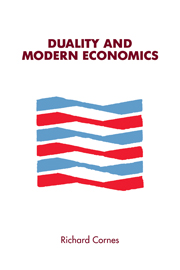Book contents
- Frontmatter
- Contents
- Preface
- PART I SOME BACKGROUND
- PART II MODELING INDIVIDUAL CONSUMER AND PRODUCER BEHAVIOR
- Chapter 2 Individual consumer behavior: Direct and indirect utility functions
- Chapter 3 Individual consumer behavior: Expenditure and distance functions
- Chapter 4 Individual consumer behavior: Further useful relationships and formulations
- Chapter 5 Producer behavior
- Chapter 6 Consumer and producer behavior: More useful topics
- Chapter 7 Consumer theory with many constraints
- PART III APPLYING THE MODEL OF INDIVIDUAL BEHAVIOR
- Epilogue
- Bibliography
- Author index
- Subject index
Chapter 4 - Individual consumer behavior: Further useful relationships and formulations
Published online by Cambridge University Press: 11 September 2009
- Frontmatter
- Contents
- Preface
- PART I SOME BACKGROUND
- PART II MODELING INDIVIDUAL CONSUMER AND PRODUCER BEHAVIOR
- Chapter 2 Individual consumer behavior: Direct and indirect utility functions
- Chapter 3 Individual consumer behavior: Expenditure and distance functions
- Chapter 4 Individual consumer behavior: Further useful relationships and formulations
- Chapter 5 Producer behavior
- Chapter 6 Consumer and producer behavior: More useful topics
- Chapter 7 Consumer theory with many constraints
- PART III APPLYING THE MODEL OF INDIVIDUAL BEHAVIOR
- Epilogue
- Bibliography
- Author index
- Subject index
Summary
Having assembled the basic ingredients of the demand theory, we can now set to work relating them to one another and demonstrating their various uses. We already know that the direct and indirect utility functions are related, each being the dual of the other. Similarly, the minimum expenditure and distance functions are duals. Sections 4.1 and 4.2 point out the simple relationships between the two pairs of functions. Section 4.3 is perhaps the most important. On the one hand, uncompensated demand functions are the most natural and most commonly used form, especially in the estimation of demand systems, whereas it is the system of compensated demand functions that directly reflects the a priori restrictions on behavior implied by rationality. Clearly, it is important to relate the two types of functions, so that analysis that uses the uncompensated formulation can still exploit those restrictions. This is done in Section 4.3; as with demand functions, so too with inverse demand functions, as Section 4.4 demonstrates. Section 4.5 explores the local duality relationships between demand and inverse demand systems as reflected in the relationship between the Slutsky and Antonelli matrices.
I asserted in Chapter 3 that the concept of a utility function is a direct implication of the first four axioms. Even so, the use of the word “utility” continues to worry students into thinking that economic theory has injected some unsatisfactorily metaphysical concept into the works.
- Type
- Chapter
- Information
- Duality and Modern Economics , pp. 86 - 103Publisher: Cambridge University PressPrint publication year: 1992



